Podcast Advertising: Pros, Cons, & Alternative Revenue Sources
By Daniel Ndukwu
Every year, the number of podcasts grows.
The number of engaged listeners also grows. According to the latest figures, over 50% of Americans listen to podcasts regularly.

Wherever there’s attention, advertisers looking for new audiences are sure to follow.
After getting a podcast online with the right hosting, one of the first things creators and brands do is look at how to monetize their work.
If you have a brand then the focus is usually on selling your own products. When you don’t have a brand, the focus tends to be on finding advertisers that will work with you.
This guide looks at the pros and cons of using podcast advertising to earn an income as well as alternative revenue sources to grow your income.
What is podcast advertising?
Podcast advertising is the process of mentioning a brand or company on an individual podcast episode or series of episodes in exchange for some form of consideration. Usually, the consideration is in the form of a cash payment.
The rate and amount of the payment is determined by the average reach of the episodes. In some cases, payment can be made based on the number of leads or sales generated but it’s much less common.
Advertising based on the number of people reached is called CPM (cost per mille or cost per 1,000 listeners) and the pricing can vary.
Ads range from 10 seconds to a few minutes and can be created by the podcast host themselves or a prerecorded audio file can be provided. Because of the nature of podcasts, advertisers often create individual pages or coupon codes to track the results of the campaign.
There are multiple types of podcast ads:
- Pre-roll – an ad that shows up at the beginning of a podcast
- Mid-roll – an ad that is placed in the middle of a podcast and is usually prefaced by the host mentioning a word from the sponsors.
- Outro – the last few moments of a podcast where an advertiser can get a short advertisement in.
Standard podcast advertising rates
There’s a lot of variance in the rate an advertiser pays. If you go through a service then they may negotiate rates and get a higher CPM but then they’ll take a cut which means the money paid to a podcaster is lower.
Let’s look at the averages broken down by type of advertisement.
- 10 second ad = $15 CPM
- 30 second ad = $18 CPM
- 60 seconds or more = $25 - $50 CPM
These are averages and if you read the ad yourself or help to create it, you may be able to command higher rates.
When your podcast grows, this can be an amazing way to generate a large income every year. Joe Rogan is rumored to make over $75,000 an episode. That’s not including the ads from YouTube where his videos routinely get millions of views:
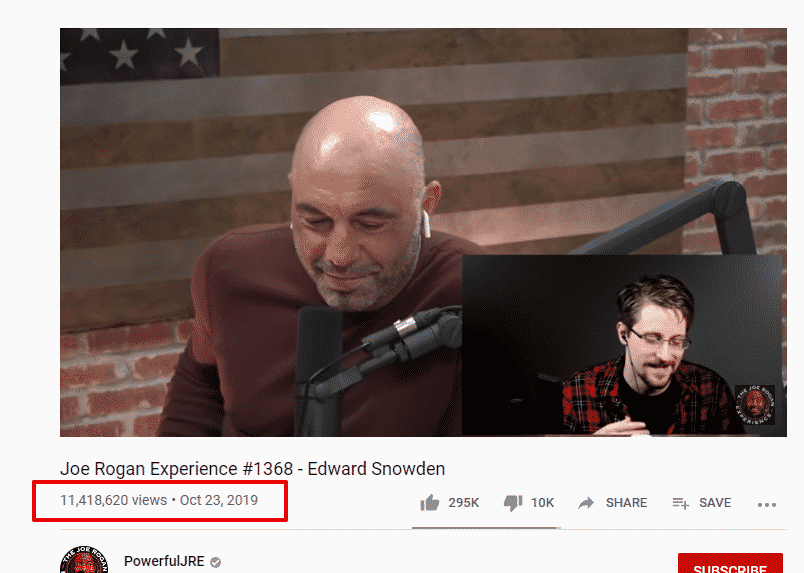
On a side note: the CPM for YouTube varies based on the niche but it’s roughly $2 - $5.
Pros of podcast advertising
There are a many pros of podcast advertising that makes it attractive to new podcasters who don’t have a brand that sells other products. A few of them include:
A quick way to generate revenue
There are tangible expenses associated launching and growing a successful podcast. Things such as equipment, editing, hosting, graphic design, etc. are all included in the ongoing costs.
A regular group of sponsors for a new podcast can offset those costs as well as provide cash to market and grow the podcast more quickly. It creates a cycle where the podcast host can expand operations, get more listeners, and receive more revenue from sponsors.
You can pen individual deals with brands
When your audience gets large enough, you won’t have to go through platforms that aggregate advertisers. Instead, you’ll be able to reach out to brands (or have them reach out to you) and create long term partnerships.
In addition to being able to get better rates, you’ll be able to build a long term relationship that may open the doors to other opportunities.
For example, you may be able to become a brand ambassador or partner with the brand on co-marketing initiatives.
Doesn’t require constant maintenance
When you have advertisers coming to you, unless otherwise agreed upon, they’ll provide the audio clip which you can insert as a pre-roll, mid-roll, or outro. If you’re so inclined, you can make the ad yourself.
This will take up the majority of your time when the ad is being created. After that, it doesn’t require any additional maintenance or changes from you.
Compare that with your own products and services. If you’re selling software like KyLeads, it’s a constant process of customer research, innovation, and optimizing funnels. If you’re selling a physical product it’s a constant process of sourcing, marketing, and segmentation.
The point is that it takes more effort to maintain a product than it does to maintain an ad.
Revenue grows as your audience grows
One of the biggest benefits of podcast advertising is that as your audience gets larger, the amount each sponsor pays to reach them gets larger.
While a larger audience tends to correlate with more income across other industries, it’s not a guarantee. That’s because you have to do additional things like optimize the funnel, create more dialed in messaging, match buyer personas with the right offers, etc.
With podcasting it’s a direct relationship. As your audience grows, your sponsorship income grows without additional effort on your part.
Cons of podcast advertising
As illustrated, there are many positives of finding advertisers for your podcast but it’s not all roses. It’s important to be aware of the downsides as well.
Limited amount of control over creatives
In the end, it’s someone else’s brand and you can’t dictate 100% how the creative sounds, even if it is aimed at your audience. If you try to take away all of the freedom from a brand, they won’t work with you for long.
There’s a balancing act between pleasing advertisers, pleasing your audience, and pleasing yourself. You’ll also see that as you attract larger brands, they have clearer (and often more rigid) guidelines about how they advertise.
If you don’t allow them to advertise the way they want then they’ll move on to the next podcast. Of course, this doesn’t mean compromise on your morals. It means you should be prepared to give your sponsors control of their ads which is a reasonable request.
Platforms can take a large cut of revenue
Advertising marketplaces help you connect with sponsors and, at times, will assist you with negotiations to get the best rate. This service isn’t free and the marketplaces or platforms have different payment models.
Some of them charge you a flat rate while others take a cut of the CPM rate they negotiated on your behalf. Get clear on the business model of the platform and the revenue share before you sign up and start using them to connect with advertisers.
It can take a lot of time and energy to attract advertisers you like.
While you can start getting sponsors almost immediately, not all of them are created equally. You may even have specific brands you want to partner with. If they’re selective about who they work with, it may be difficult to establish that initial partnership.
Almost anything can be done with a large enough audience but that takes time and focused energy to build.
If, on the other hand, you had a specific product or service for sale, it would be easier to establish co-marketing partnerships with other brands. As long as you’re bringing a tangible benefit to the table, they’ll consider working with you.
Alternative podcast income sources for podcasters
Even if you want to get advertisers for your podcast, that doesn’t mean you shouldn’t take advantage of other streams of income. In fact, you stand to gain the most by monetizing through direct and indirect means.
Jon Lee Dumas of EOFire is transparent about his income and breaks down how he generates revenue:
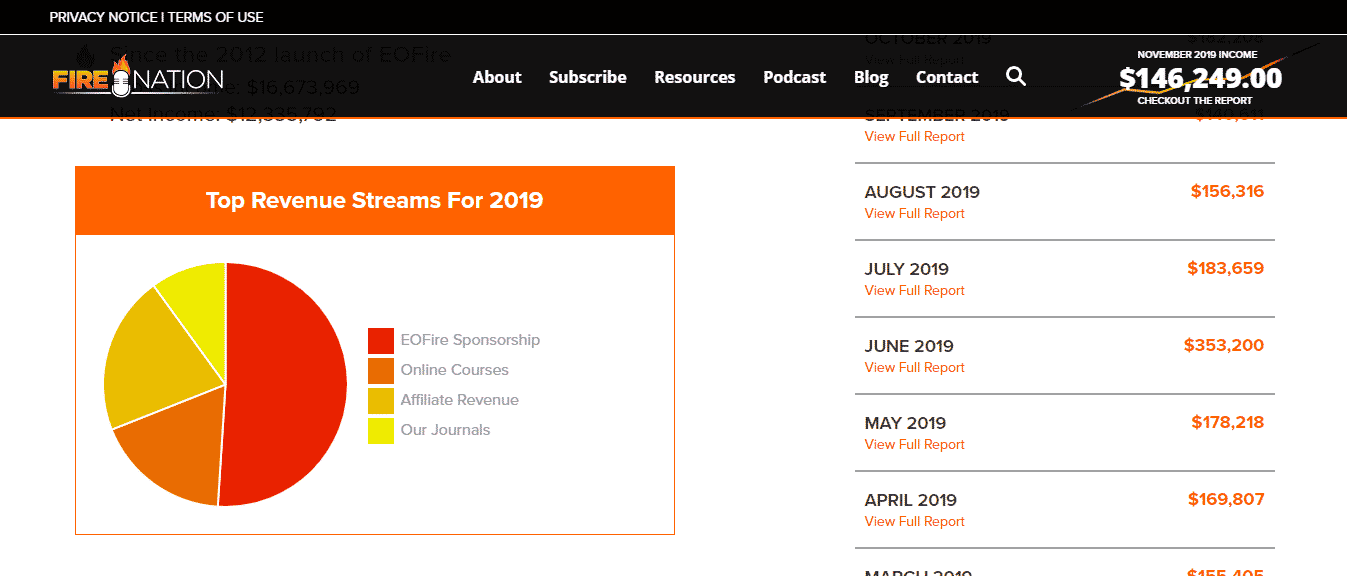
As you can see from the graphic above, it’s a mix of his own products, affiliate marketing, and sponsorships. Here are a few ways you can increase your revenue when hosting a podcast.
Accepting donations
Donations may not work in all instances but they can be a viable option if your audience is growing and you don’t want to use ads or want to sell your own products. Some niches just don’t spend much money.
For example, a podcast about ancient history may not be able to sell products directly.
They can, of course, get sponsors but what if that doesn’t interest them? Accepting donations from a fan base that truly cares about what they’re doing is a viable option.
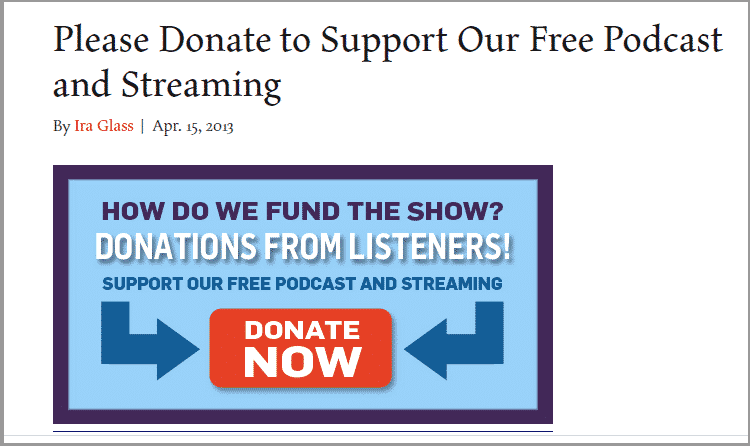
Selling digital products
This may be the most effective way to monetize your podcast. The cost of fulfillment is negligible and there are no marginal costs for each unit. It’s produced once and continue to be sold.
Of course, you’ll need to update it but the bulk of the effort occurs when you’re creating it. Focus on a product that’s closely tied to what you talk about on your podcast. If you talk about fashion, create an Ebook about a specific aspect of fashion for your audience.
Another way to create a digital product is to allow your audience to become premium members that pay a monthly fee for access to specific content.
This is ideal because you’re already creating episodes. Instead of one per week, you can create 2 per week. One is for everybody and the other is for premium subscribers.
Affiliate partnerships
Affiliate marketing is one of the most powerful ways to create a sizeable income without building your own products and services.
The concept is simple, you promote products you personally use or believe in and recommend them to your audience. If people who click your link end up purchasing, you get a cut of the sale amount.
The percentage you’re compensated varies widely. Some products on Amazon only pay out 4% while some software companies such as Semrush pay out 40% or more for the lifetime of the customer.
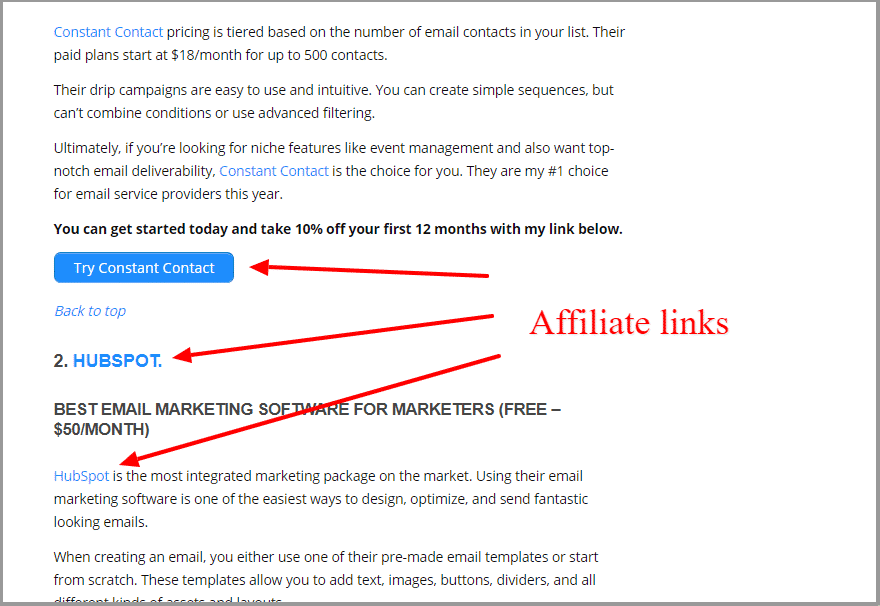
Before you recommend any product, make sure it’s high quality and won’t rub your audience members the wrong way. For example, if you recommend a product that has shady business practices and one of your audience members is burned, it’ll reflect poorly on you.
Conclusion
Podcast advertising can be a viable way to increase revenue or get the word out for a brand. There are many pros and a few cons which were touched on in the article.
Whether you take advantage of it or not, it’s important to also consider other ways of monetization so your income is diversified. If the advertising, for some reason, dries up then you know you’ll be able to fall back on those other channels to keep producing a sizeable income.
Copyright 2018 - 2020, KyLeads. All rights reserved.
